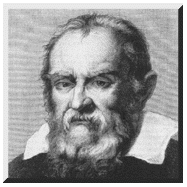 Galileo
Galilei (1564-1642)
was the oldest of seven children born to Vincenzo Galilei
and Giulia Ammanati. He entered the University of Pisa in 1581 to
study medicine. Soon he realized that his interests were not in
medicine, but mathematics. After only a year in the university, he
made his famous discovery of the isochronal movement of
pendulums.
Galileo
Galilei (1564-1642)
was the oldest of seven children born to Vincenzo Galilei
and Giulia Ammanati. He entered the University of Pisa in 1581 to
study medicine. Soon he realized that his interests were not in
medicine, but mathematics. After only a year in the university, he
made his famous discovery of the isochronal movement of
pendulums.
He then continued an independent study of science and mathematics while trying to convince his father to allow him to study science and math. In 1586 Galileo withdrew from the University of Pisa without a degree and headed back to live with his family. For the next few years he continued his study of science and gave a series of lectures on the Inferno of Dante's The Divine Comedy at the Florentine Academy. Galileo had many influential friends who were able to help him gain an appointment as a lecturer of mathematics at the University of Pisa in 1859 and then as the chair of mathematics at the University of Padua in 1592.
Galileo Galilei's accomplishments
1597
1. see craters on the moon, which was previously thought to be a smooth sphere.
2. discover four moons around Jupiter. The only planet believed to have a moon was the Earth
3. observe Venus shows phases (just like the moon of the Earth.)
Page created by: Mike
Cowen
Drake, S. 1983, Telescopes, Tides and Tactics. University of Chicago Press, Chicago.
Wallace, W.A., 1992 Galileo's Logic of Discovery and
Proof., Kliwer Academic Publishers.
Other world wide web sites about Galileo Galilei :
http://galileo.imss.firinze.it/museo/
http://es.rice.edu:80/ES/humsoc/Galileo/
http://
muse.tau.ac.il/~museum/